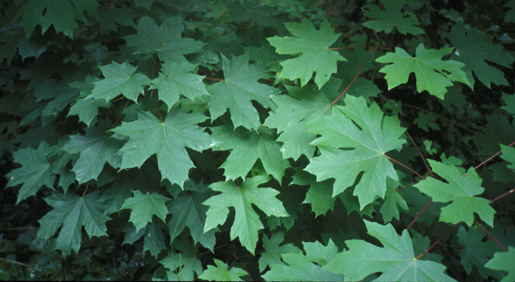
|
Norway Maple (left); Bigleaf Maple (right)
|
Wild tree changes over 150 years in Seattle
|
| Seattle was almost wholly forested before the boom of European-based settlement in the 1850s. Settlers logged the forests, introduced new species, and made a big city of bright lights. After some 150 years of dramatic and subtle changes, today our urban forest is fragmented, consisting of diverse isolated parks and greenbelts. Street trees planted like pawns on a chessboard among downtown skyscrapers are not a forest. The original forest supported some 30 species of trees, plus associated shrubs, vines, wildflowers, ferns, mosses and wildlife. Today's forests still contain the original 30 or so native tree species, plus many introduced species naturalized here. |
| In several cases native species are being replaced by naturalized species, evidently because the latter reproduce more effectively -- survival of the fittest. Thus sapling English yews greatly outnumber Pacific yews; Norway maples outnumber bigleaf maples in many parks. This is not necessarily bad. Species are native to certain conditions, which change over time, thus the range of individual species variously expands or contracts. It is a gross simplification to assume that pre-settlement native species are inherently better in the web of life than newcomers. Unfortunately, the prevailing trend among academics is to restrict the term native to a certain fixed time and place: those species which were wild in a given locale or environment in a certain period. There is a constant flux of species composition in any given place. |
| Since Seattle has had none of its original tree species extirpated, the additional foreign ones now wild here with them are a net addition to our flora. Our tree diversity was relatively low because the last glaciation was only 13,500-15,000 years ago. Those of us who accept the premise of biologic diversity being desirable should be content. Those not content to watch nature take its course, can roll up their sleeves and do hands-on diversity promotion such as native habitat enhancement projects. For example, since our few native oaks scarcely reproduce on their own, we can collect their acorns, and plant them ourselves in appropriate sites. |
| Ongoing intervention (literally indefinitely) is the only way parks and greenbelts can be kept from natural evolution of species mixes. Nature will see to it that weak species give way to stronger ones. This happens two ways. Sometimes weak species just die out or stop reproducing, so stronger species move into the void. Other times, stronger species simply overwhelm existing weaker ones, like a big fish swallowing a little one. People who are unhappy with this natural succession can act as forces of change. This raises interesting philosophic and semantic issues: An area is truly wild only if people don't intentionally alter it, any more than animals intentionally alter their environment. When humans intentionally alter places we are more or less "gardening" or "editing" (some say "playing God"). Another term used is stewardship. |
Is thoughtful human intervention desirable or is the hands-off approach best? You decide. Are we to "take only pictures and leave only footprints?" Or to attack "weedy" species, and coddle weak ones until they can survive by themselves? Being able to ask and act upon this sort of question is what sets apart humans from all else in creation. A healthy environment is a balanced, diverse one. Want to help change the world? Although even one individual can make a great difference, it is preferable to work in concert (as with the Audubon Society, Washington Native Plant Society, TREEmendous Seattle, the Adopt-a-Park program, the Thornton Creek Alliance, Green Lake Park Alliance, etc.). Numerous organizations exist. Find one that fits your preferences. An excellent guide to many is Stephanie Feeney's Northwest Gardener's Resource Directory (8th ed., April 1999).
|
| Top 10 native tree species: |
| Red ALDER -- Alnus rubra |
| Oregon ASH -- Fraxinus latifolia |
| Western Red CEDAR -- Thuja plicata |
| Black COTTONWOOD -- Populus trichocarpa |
| Douglas FIR -- Pseudotsuga Menziesii |
| Grand FIR -- Abies grandis |
| Western HEMLOCK -- Tsuga heterophylla |
| MADRONA -- Arbutus Menziesii |
| Bigleaf MAPLE -- Acer macrophyllum |
Western White PINE -- Pinus monticola
|
| Top 10 non-native tree species wild in shady places & woods: |
| Mazzard CHERRY -- Prunus avium |
| Common HAWTHORN -- Cratægus monogyna |
| English HOLLY -- Ilex Aquifolium |
| HORSE CHESTNUT -- Æsculus Hippocastanum |
| English LAUREL -- Prunus Laurocerasus |
| Portugal LAUREL -- Prunus lusitanica |
| Norway MAPLE -- Acer platanoides |
| Sycamore MAPLE -- Acer Pseudoplatanus |
| English OAK -- Quercus robur |
English YEW -- Taxus baccata
|
| Top 10 non-native tree species wild in open places: |
| Common APPLE -- Malus domestica |
| Downy BIRCH -- Betula pubescens |
| White BIRCH -- Betula pendula |
| Black LOCUST -- Robinia Pseudoacacia |
| European MOUNTAIN ASH -- Sorbus aucuparia |
| European PEAR -- Pyrus communis |
| Flowering PLUM -- Prunus cerasifera |
| Lombardy POPLAR -- Populus nigra 'Italica' |
| Black WALNUT -- Juglans nigra |
White WILLOW -- Salix alba
|
(The article above was written in January 2000 and published in Earthcare Northwest, the newsletter of the Seattle Audubon Society. Some of the words found their way into my book Wild Plants of Greater Seattle).
Back |

